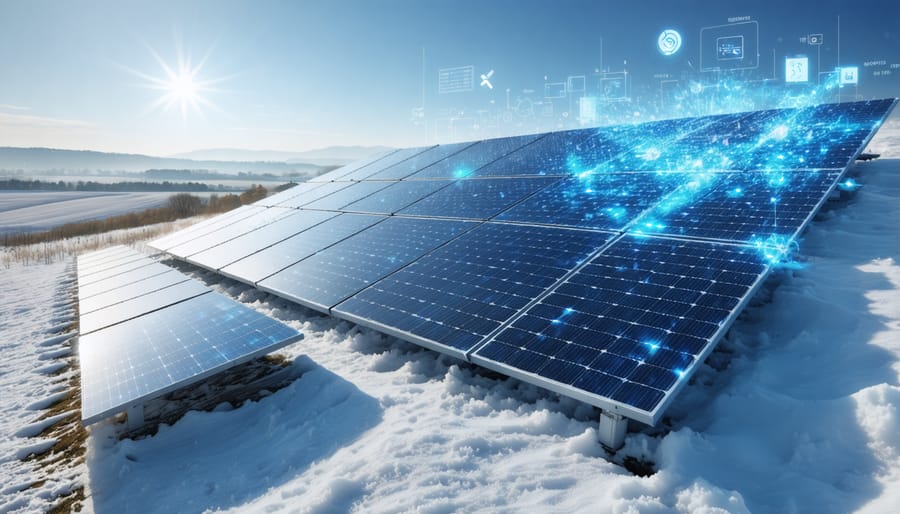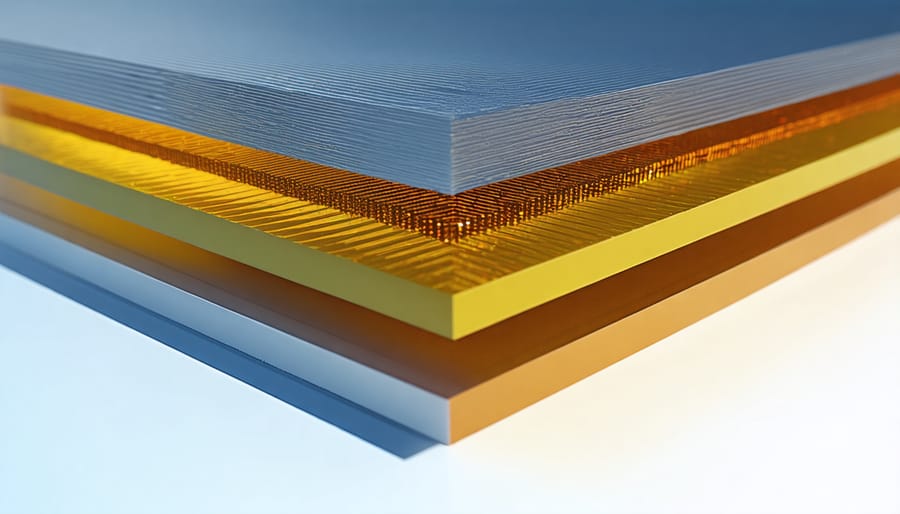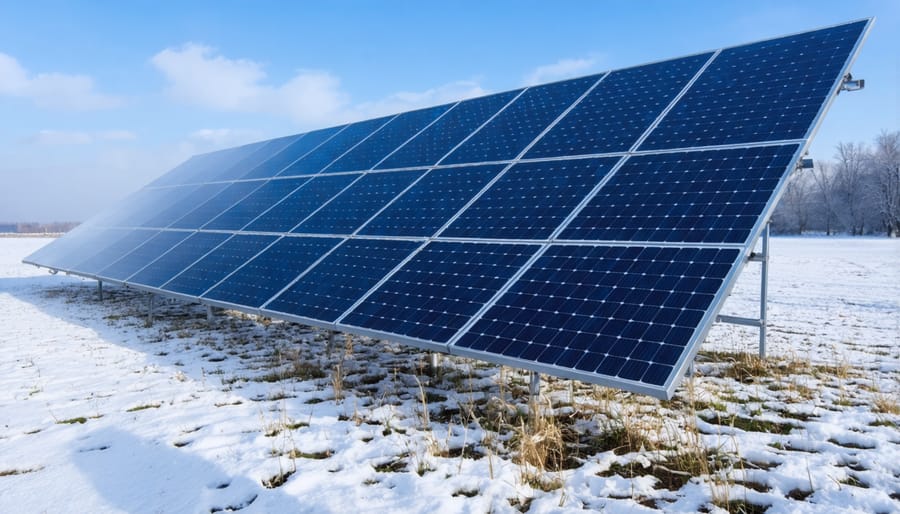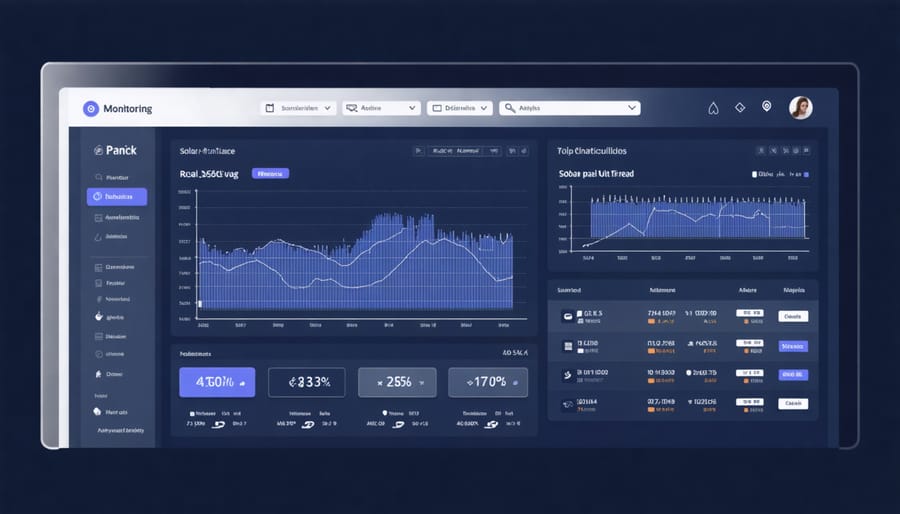These Breakthrough Solar Panel Technologies Are Reshaping European Energy

Solar technology stands at the cusp of a remarkable transformation, with innovations reshaping how we harness the sun’s power. From perovskite cells achieving record-breaking efficiency levels to transparent solar panels that transform ordinary windows into power generators, the landscape of photovoltaic technology is evolving at an unprecedented pace. In European markets, where sustainability meets innovation, these advancements are particularly significant, offering solutions that address both environmental imperatives and practical energy needs.
Recent breakthroughs in solar panel design have pushed efficiency boundaries beyond 40% in laboratory conditions, while commercial applications are rapidly approaching 25% efficiency – a marked improvement from the 15% standard just a decade ago. These developments, coupled with smart integration technologies and enhanced durability, are making solar energy more accessible and economically viable for both residential and industrial applications.
As we witness this solar revolution, the focus extends beyond mere efficiency gains. Today’s innovations encompass self-cleaning surfaces, bifacial panels that capture reflected light, and AI-driven optimization systems that maximize energy yield in real-world conditions. For European stakeholders, these advancements represent not just technological progress, but a pathway to energy independence and sustainable economic growth.
Perovskite Solar Cells: The Next Generation of Solar Technology

Enhanced Efficiency Breakthroughs
Recent breakthroughs in solar panel technology have delivered remarkable latest efficiency improvements, pushing the boundaries of what’s possible in solar energy generation. European research laboratories have achieved conversion rates exceeding 26% in commercial-grade silicon solar cells, marking a significant advancement over traditional 15-20% efficiency ratings.
These improvements stem from innovative cell architectures, including the implementation of heterojunction technology and advanced light-trapping techniques. Researchers have successfully developed multi-junction cells that capture a broader spectrum of sunlight, while new anti-reflective coatings minimize energy loss through reflection.
Particularly noteworthy is the emergence of perovskite-silicon tandem cells, which have demonstrated efficiency rates approaching 30% in laboratory conditions. These next-generation cells combine the stability of silicon with the superior light-absorption properties of perovskite materials, offering a promising path forward for commercial applications.
European manufacturers have already begun incorporating these innovations into production lines, with several facilities now producing modules that consistently achieve 23-24% efficiency under real-world conditions. This translates to significantly higher energy yield per square meter, making solar installations more practical and cost-effective for both residential and commercial applications.
Commercial Viability Timeline
Perovskite solar technology is approaching a crucial transition from laboratory success to commercial reality. Industry experts predict that the first commercial perovskite-enhanced solar panels could reach European markets by 2025, with widespread adoption expected between 2026 and 2028. Leading research institutions across Europe, including those in Oxford, Switzerland, and Germany, are currently conducting final-phase stability tests and scaling up production processes.
The primary milestone for commercial viability revolves around achieving a minimum 20-year operational lifespan, matching current silicon-based panels. Recent breakthroughs in encapsulation techniques and material stability have extended perovskite cell durability from months to several years, marking significant progress toward this goal.
Manufacturing scalability is advancing rapidly, with pilot production lines already operational in several European facilities. These operations demonstrate the potential for cost-effective mass production, with preliminary estimates suggesting a 30% reduction in manufacturing costs compared to traditional solar panels.
Key challenges remaining include standardisation of production processes, certification under European renewable energy regulations, and establishment of reliable supply chains. Industry partnerships between research institutions and manufacturing giants are accelerating these developments, with substantial investment flowing into production infrastructure.
For European consumers and businesses planning solar installations, the advice is to proceed with current technology while remaining informed about perovskite developments, as the technology’s commercial introduction will likely occur in phases, starting with hybrid silicon-perovskite panels before transitioning to pure perovskite solutions.
Bifacial Solar Panels: Maximizing Energy Capture
Performance in European Climate Conditions
Bifacial solar panels have demonstrated remarkable adaptability across diverse European climate conditions, showing particular strength in northern regions where reflected light from snow can boost energy yield by up to 30% during winter months. In central European countries like Germany and France, these innovative panels have consistently outperformed traditional models by 5-15%, especially in areas with high albedo surfaces such as light-colored rooftops or ground covers.
Testing across multiple European installations reveals that bifacial panels maintain optimal performance even in diffuse light conditions, common in countries like the Netherlands and Belgium. Urban installations have shown surprising efficiency gains of 8-12% due to light reflection from surrounding buildings and pale surfaces.
Southern European nations benefit from both direct sunlight and reflected radiation, with Mediterranean installations reporting annual energy yields 10-20% higher than conventional panels. The performance advantage becomes particularly notable during morning and evening hours, extending the daily production curve and improving overall system economics.
Climate-specific testing has confirmed these panels’ resilience to varying weather patterns, from Nordic snow to Mediterranean heat, making them an increasingly popular choice for European solar projects.

Installation Considerations
Successful solar panel installation requires careful consideration of several key factors to maximize energy generation and system longevity. The optimal orientation in European locations typically faces south, with an inclination angle between 30-40 degrees, though specific adjustments may be needed based on your geographical location and local climate patterns.
Roof structural integrity is paramount before installation. Modern solar systems, while lighter than previous generations, still require proper support. Professional assessment ensures your roof can handle the additional load and identifies any necessary reinforcement needs.
Shading analysis has become increasingly sophisticated with new digital tools. Even partial shade from nearby buildings, trees, or chimneys can significantly impact panel performance, especially with traditional string inverter setups. However, innovative technologies like micro-inverters and power optimizers can help mitigate these effects.
Local regulations and grid connection requirements vary across European regions. Many municipalities now offer streamlined permitting processes for solar installations, though heritage building restrictions may apply in certain areas. It’s essential to verify these requirements early in the planning phase.
Consider future expansion possibilities when designing your system. Modern mounting systems allow for easier panel additions, and smart inverters can be sized to accommodate potential system growth. Energy storage integration should also be factored into initial planning, even if battery installation is planned for a later date.
Smart Solar Integration Technologies

Real-time Performance Monitoring
Modern solar installations are revolutionizing energy management through advanced smart monitoring capabilities that provide unprecedented insight into system performance. These intelligent monitoring systems collect and analyze real-time data from every panel, offering property owners complete visibility into their solar investment’s operation.
Using sophisticated sensors and IoT technology, these systems track crucial parameters including power output, voltage levels, and operating temperature. This continuous monitoring enables swift detection of performance issues, from simple dust accumulation to potential component malfunctions, ensuring optimal energy generation throughout the system’s lifetime.
Property owners can access detailed performance metrics through user-friendly mobile apps or web platforms, making it simple to track energy production, consumption patterns, and cost savings. The systems automatically generate alerts when maintenance is required, helping prevent energy losses and extending equipment lifespan.
For businesses and industrial installations, these monitoring solutions integrate seamlessly with building management systems, enabling sophisticated energy optimization strategies. The collected data supports predictive maintenance schedules and helps identify opportunities for efficiency improvements.
Most importantly, real-time monitoring provides transparency and confidence in solar investments by delivering concrete performance metrics and clear return-on-investment data, making it easier for European property owners to maximize their renewable energy benefits.
Predictive Maintenance Systems
Predictive maintenance systems represent a significant leap forward in solar panel management, leveraging artificial intelligence and machine learning to optimize performance and longevity. These intelligent systems continuously monitor key parameters such as power output, temperature variations, and weather conditions to detect potential issues before they escalate into serious problems.
Modern solar installations now incorporate sophisticated sensor networks that collect real-time data on panel performance. This data feeds into AI algorithms that can identify subtle patterns indicating potential maintenance needs. For instance, the system can detect gradual efficiency declines that might suggest dust accumulation or detect unusual voltage patterns that could indicate developing micro-cracks.
European solar facilities have been particularly successful in implementing these smart maintenance solutions. In Germany, several large-scale solar farms have reported up to 30% reduction in maintenance costs and a 15% increase in overall system efficiency after adopting predictive maintenance systems.
The technology also enables customised maintenance schedules based on local environmental conditions. For coastal installations, where salt exposure is a concern, or alpine locations with heavy snow loads, the AI adjusts maintenance recommendations accordingly. This targeted approach ensures optimal performance while reducing unnecessary maintenance visits.
For homeowners and businesses, these systems typically integrate with smart home platforms, providing easy-to-understand maintenance alerts and performance reports through mobile applications. This accessibility helps users maintain their solar investments more effectively while maximizing energy generation potential.
Sustainable Manufacturing Innovations
Reduced Carbon Footprint Production
The solar industry’s commitment to sustainability extends beyond the panels themselves to their manufacturing processes. Recent innovations in production methods have significantly reduced the carbon footprint of solar panel manufacturing, making solar energy an even greener choice for European consumers and businesses.
Advanced recycling systems now allow manufacturers to recover up to 95% of raw materials from old panels, significantly reducing the need for new resource extraction. This circular approach has decreased production-related emissions by approximately 30% compared to traditional manufacturing methods.
European manufacturers have pioneered the use of renewable energy in their production facilities, with many factories now powered entirely by solar and wind energy. This transformation has created a virtually carbon-neutral manufacturing cycle, where solar panels are essentially producing more solar panels.
Water consumption in production has also seen remarkable improvements, with new cooling systems reducing water usage by up to 75%. Innovative dry-cleaning processes for silicon wafers have further decreased both water consumption and chemical usage, making the manufacturing process more environmentally friendly.
The implementation of AI-driven quality control systems has optimized production efficiency, reducing waste and energy consumption while maintaining high standards. These smart systems can predict and prevent manufacturing defects, ensuring resources are used optimally.
Local production facilities across Europe have shortened supply chains, reducing transportation-related emissions while supporting regional economies. This localized approach has cut logistics-related carbon emissions by an average of 40% while ensuring faster delivery times and better service for European customers.
These advancements in sustainable manufacturing have created a positive feedback loop, where the environmental benefits of solar energy begin even before installation, making solar power an increasingly attractive option for environmentally conscious consumers and businesses.
End-of-Life Solutions
As solar installations continue to grow across Europe, the industry is increasingly focusing on sustainable end-of-life solutions for solar panels. Modern recycling facilities can now recover up to 95% of materials from decommissioned panels, including valuable components like silver, silicon, and aluminum. This circular economy approach significantly reduces the environmental impact while creating new economic opportunities.
Several European countries have implemented comprehensive recycling programs through the WEEE (Waste Electrical and Electronic Equipment) directive, establishing dedicated collection points and processing centers. France and Germany lead the way with innovative recycling technologies that separate and process different panel components through automated systems, ensuring maximum material recovery.
The recycling process typically involves mechanical separation, thermal treatment, and chemical processing to extract pure materials that can be used in manufacturing new panels or other products. This approach not only conserves resources but also reduces the carbon footprint associated with raw material extraction.
Manufacturers are also embracing eco-design principles, developing panels that are easier to dismantle and recycle. These “design for recycling” initiatives include using alternative materials, reducing the number of different components, and implementing standardized construction methods that simplify the end-of-life handling process.
Looking ahead, the European solar industry is investing in research to improve recycling efficiency and develop new technologies for handling next-generation panels, ensuring sustainable growth of solar energy deployment across the continent.
The remarkable innovations in solar panel technology are fundamentally reshaping Europe’s energy landscape. From advanced bifacial panels to groundbreaking perovskite cells, these developments are making solar power more accessible, efficient, and economically viable for European stakeholders across all sectors.
The impact is particularly evident in regions previously considered less suitable for solar adoption. Enhanced low-light performance and improved durability mean that countries in Northern Europe can now benefit from solar technology just as effectively as their Southern counterparts. This democratization of solar energy access is accelerating Europe’s transition toward renewable energy independence.
For homeowners and businesses, these innovations translate into tangible benefits: shorter payback periods, increased property values, and reduced energy costs. The integration of smart monitoring systems and AI-driven optimization tools has made solar installations more user-friendly and efficient than ever before.
Looking ahead, the European solar market stands at the cusp of a transformative period. With continued research and development in areas like transparent solar cells and advanced energy storage solutions, the potential for widespread adoption is immense. These innovations are not just technological achievements; they represent crucial steps toward meeting the EU’s ambitious climate goals and establishing a sustainable energy future for generations to come.
The cumulative effect of these advancements positions Europe as a global leader in solar energy adoption, creating new opportunities for economic growth while addressing urgent environmental challenges.
Leave a Reply